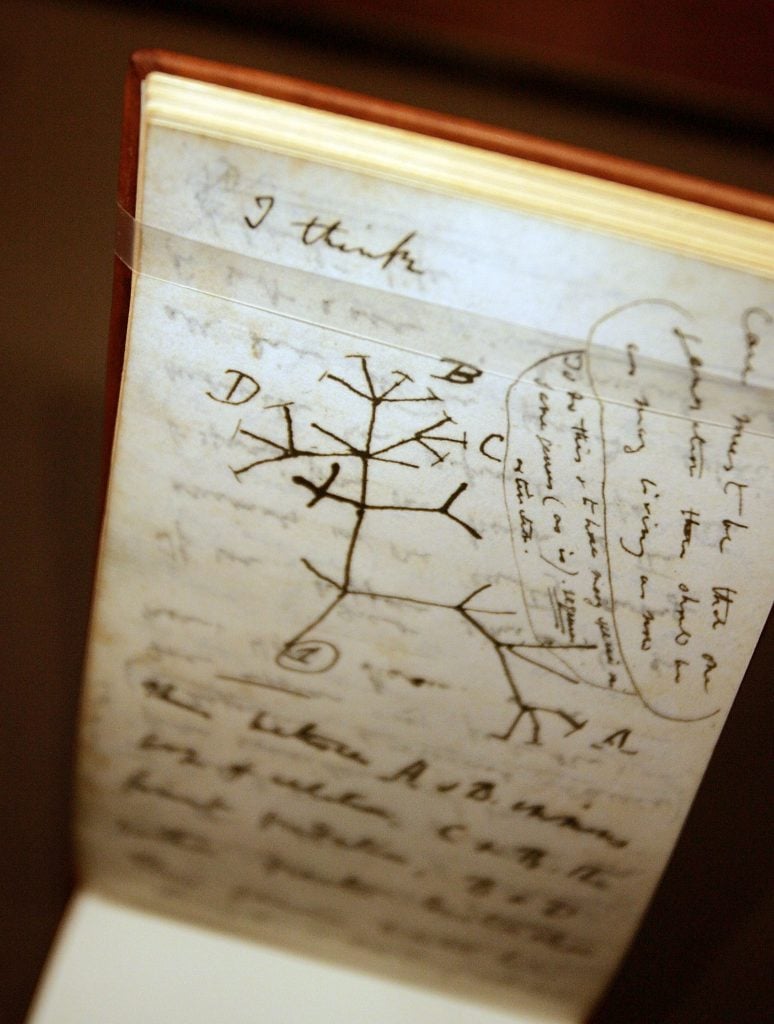Art World
Decades After They Went Missing, Two of Charles Darwin’s Notebooks Were Returned Anonymously to Cambridge University
The books were removed from a special collections room in 2000, leading to an international manhunt.

The books were removed from a special collections room in 2000, leading to an international manhunt.

Caroline Goldstein

Librarians of the world, rejoice!
Two of Charles Darwin’s notebooks containing his famed Tree of Life sketch were returned to the Cambridge University library more than two decades after they were first reported missing.
A mysterious pink gift bag was left on the floor of the library with a cheeky note that read simply, “Librarian, Happy Easter X.”
Inside, the two small leather-bound books were wrapped in clingfilm inside their archive box, and slipped into a plain brown envelope.
“They may be tiny, just the size of postcards, but the notebooks’ impact on the history of science, and their importance to our world-class collections here, cannot be overstated,” Jessica Gardner, the head Cambridge University librarian, said in a statement.
Sketched in 1837, Darwin’s Tree of Life was a fundamental component of his theory of evolution through natural selection, and was the subject of a 2009 BBC documentary released to celebrate the bicentenary of Darwin’s birth.
In his 1859 treatise, On the Origin of Species, Darwin wrote: “The affinities of all the beings of the same class have sometimes been represented by a great tree. I believe this simile largely speaks the truth.”

Darwin’s B notebook contains his iconic Tree of Life Sketch. The notebooks were returned to the University Library wrapped in the clingfilm seen here. Courtesy of the Cambridge University Library.
The story of the missing notebooks goes back to 2000, when they were removed from their home in a special collections’ room to be photographed. A year later, during a routine check of the room, librarians realized the books were never returned. In 2020, the staff undertook a thorough “finger-tip” search of specific areas of the library, including the 189 boxes that comprise the Darwin Archive, in hopes they had been misplaced.
When nothing turned up, Gardner issued a worldwide appeal for the priceless notebooks and enlisted the help of the Cambridgeshire Police and Interpol. Their disappearance was also recorded on the Art Loss Register.
“The building has transformed significantly since the notebooks were first reported as missing,” Gardner explained, noting new security systems, special reading rooms, CCTV, card-and-pin access, and a dedicated security team.
“The sole aim of our public appeal was to have the manuscripts safely returned to our safekeeping and I am delighted to have had such a successful outcome in such a relatively short space of time,” Gardner said.
Now that the notebooks are back home, they will be included in the upcoming exhibition “Darwin in Conversation,” which explores “the endlessly curious life and letters” of the scientist, who wrote and received more than 15,000 letters throughout his life, according to an exhibition statement.
The show marks the completion of the 40-year Darwin Correspondence Project, which sought to publish his letters in full.
“Darwin in Conversation” is on view at the Milstein Exhibition Centre, Cambridge University Library, July 9 through December 4, 2022; it will travel to the New York Public Library in 2023.